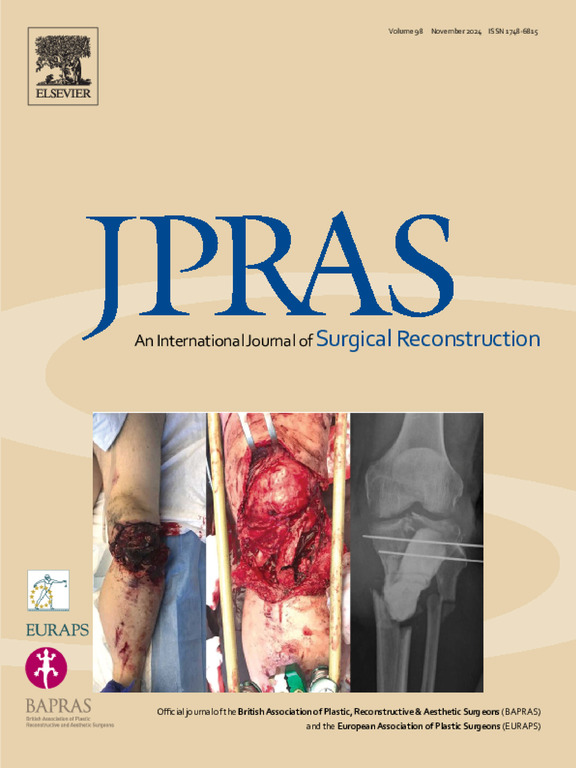Dual-port and single-port tissue expanders in postmastectomy breast reconstruction: A retrospective cohort study
IF 2
3区 医学
Q2 SURGERY
Journal of Plastic Reconstructive and Aesthetic Surgery
Pub Date : 2025-03-01
DOI:10.1016/j.bjps.2023.09.019
引用次数: 0
Abstract
Background
Novel dual-port tissue expanders allow easy access to the periprosthetic space for seroma drainage and potentially reduce risk of infection or reconstruction failure. We analyzed outcomes after first-stage alloplastic breast reconstruction in patients receiving dual-port tissue expanders in comparison to those of patients receiving traditional, single-port devices.
Methods
We retrospectively reviewed patients who underwent tissue expander placement from 2020 to 2021. A propensity-matched analysis was performed to compare the incidence of reconstruction failure in dual- and single-port expanders. Secondary outcomes included rates of seroma, hematoma, skin necrosis, wound dehiscence, surgical site infection, and patient-reported outcome measures.
Results
After propensity matching, the dual- and single-port cohorts each INCLUDED 190 breasts. There was no difference in reconstruction failure rate (17% vs. 15%, p = 0.48). Dual-port expanders had a significantly higher incidence of surgical site infections (20% vs. 12%, p = 0.04), but fewer infected dual-port expanders were explanted (58% vs. 91% of infections, p = 0.006). The remaining complication rates did not differ. Patient-reported pain interference was significantly higher in the dual-port cohort (59.1 vs. 56, p = 0.02).
Conclusions
Reconstruction failure rates did not differ when using single- or dual-port tissue expanders. Increased incidence of surgical site infections in dual-port expanders, possibly attributable to increased detection, and increased rate of salvage of the infected expanders were observed.
双孔和单孔组织扩张器在乳房切除术后乳房重建中的应用:一项回顾性队列研究
新型双口组织扩张器可以方便地进入假体周围空间进行血肿引流,并潜在地降低感染或重建失败的风险。我们分析了接受双孔组织扩张器和传统单孔组织扩张器的患者在一期异体乳房重建后的结果。方法回顾性分析2020年至2021年接受组织扩张器放置的患者。进行倾向匹配分析,比较双端口和单端口扩张器重建失败的发生率。次要结局包括血肿、血肿、皮肤坏死、伤口裂开、手术部位感染的发生率和患者报告的结局措施。结果经倾向匹配后,双端口和单端口队列各包含190个乳房。重建失败率差异无统计学意义(17% vs 15%, p=0.48)。双口扩张器的手术部位感染发生率明显较高(20%对12%,p=0.04),但较少的感染双口扩张器被拔出(58%对91%的感染,p=0.006)。其余并发症发生率无差异。患者报告的疼痛干扰在双端口队列中明显更高(59.1 vs 56, p=0.02)。结论使用单口和双口组织扩张器重建失败率无显著差异。双口扩张器手术部位感染的发生率增加,可能是由于检测增加,以及这些感染扩张器的抢救率增加。
本文章由计算机程序翻译,如有差异,请以英文原文为准。
求助全文
约1分钟内获得全文
求助全文
来源期刊
CiteScore
3.10
自引率
11.10%
发文量
578
审稿时长
3.5 months
期刊介绍:
JPRAS An International Journal of Surgical Reconstruction is one of the world''s leading international journals, covering all the reconstructive and aesthetic aspects of plastic surgery.
The journal presents the latest surgical procedures with audit and outcome studies of new and established techniques in plastic surgery including: cleft lip and palate and other heads and neck surgery, hand surgery, lower limb trauma, burns, skin cancer, breast surgery and aesthetic surgery.

 求助内容:
求助内容: 应助结果提醒方式:
应助结果提醒方式:


